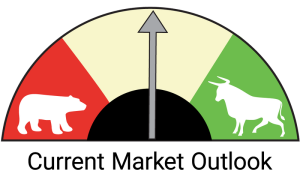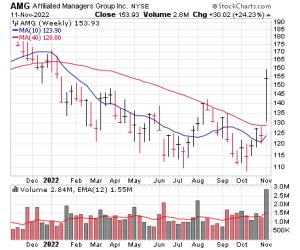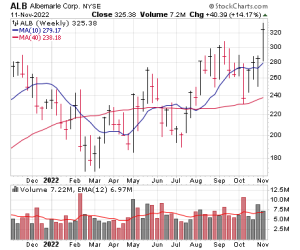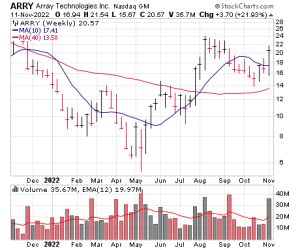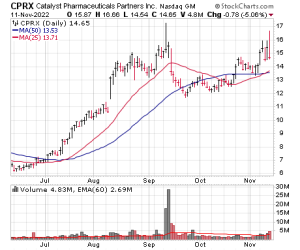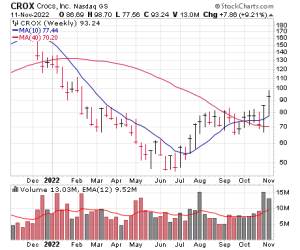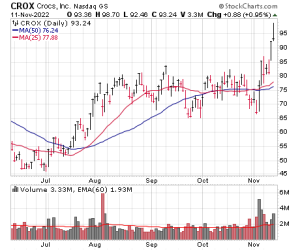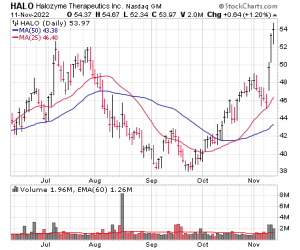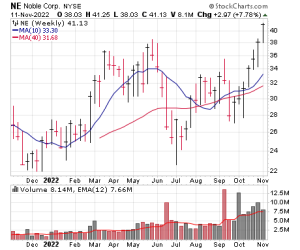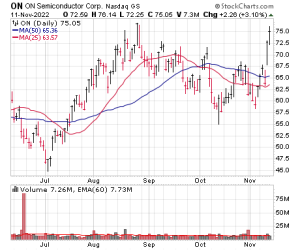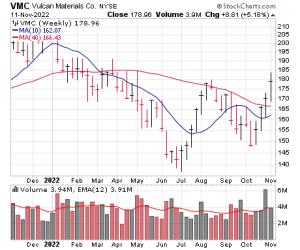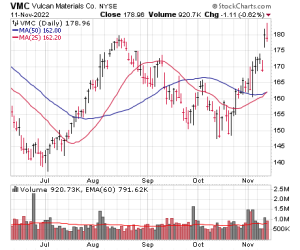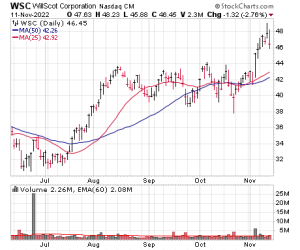Download Issue PDF
Top-Down: Encouraging. Bottom-Up: Still Tricky
The intermediate-term trend was on the verge of turning up for a couple of weeks, and the better-than-expected inflation report was enough to turn flip the switch. That said, some bigger picture evidence is still iffy (long-term trend remains down, etc.), and most important to us, there remain plenty of “accidents” out there—stocks that look good one day and blow up the next, especially those that are testing (or just nosed above) key resistance. That’s not a reason to ignore the improvement in the overall evidence; we’re moving our Market Monitor up to a level 5 for the first time in a while. But we continue to think being selective and keeping things small (and using relatively loose stops given the volatility) makes sense. If this rally is the real deal, we’ll see things break out soon enough, but there’s no reason to get too far in front of your skis just yet.
This week’s list has a nice batch of strong stocks, most of which took off as soon as the pressure came off the overall market. Our Top Pick is Albemarle (ALB), which has shown signs of wanting to go higher in recent months and was one of the first to leap to new highs last week. We’re game for a small position here or on weakness, with the goal of buying more on further upside.
| Stock Name | Price | Buy Range | Loss Limit |
| Affiliated Managers (AMG) | 153 | 148-153 | 132-135 |
| Albemarle (ALB) ★ TOP PICK ★ | 316 | 308-318 | 263-270 |
| Array Technologies (ARRY) | 19 | 18.3-19.3 | 15.2-16.2 |
| Catalyst Pharma (CPRX) | 16 | 15.0-15.7 | 12.3-12.8 |
| Crocs (CROX) | 91 | 86-90 | 73-75 |
| Halozyme (HALO) | 54 | 52-55 | 45-47 |
| Noble Corp (NE) | 41 | 38.5-40.5 | 33.5-34.5 |
| Onsemi (ON) | 73 | 70.5-73 | 61-63 |
| Vulcan Materials (VMC) | 175 | 174-178 | 157-160 |
| WillScot Mobile (WSC) | 46 | 45-47 | 40-41 |
STOCK 1
Affiliated Managers (AMG)
| Price | Buy Range | Loss Limit |
| 153 | 125-129 | 112-114 |
Why the Strength
The past year has been a volatile one for asset managers like Affiliated Managers Group, which is a collection of hedge funds, including AQR, and mutual fund operators, like Tweedy Browne. It’s not news the inflation-driven bear market has affected investment returns and sparked investors to pull their money from funds. That makes AMG’s third quarter earnings beat all the more impressive. Q3, announced last week, saw the business post a 1% revenue gain over 2021 at despite the tough environment, while earnings per share of $4.21 lifted 5% and topped expectations by 31 cents. The downside was net outflows across the business, which put average assets under management nearly 10% below 2021 levels. Management points to its diverse business model of different strategies which allow the overall company to do well in all types of markets. At its most basic, about half of its assets (52%) are invested in equities, 41% in alternatives with its hedge fund group and the balance in fixed income. Despite the asset outflows, Affiliated says it continues to see good traction in growth areas such as high net worth management and ESG investing – it owns ESG fund leader Parnassus – which should provide for long-term growth rates in the teens. More immediately, the company sounded an upbeat note in its earnings call, expecting fee revenue to jump as market-besting strategies come to fruition. Results have also been helped by a $500 million share buyback this year. All in, Wall Street doesn’t see much growth, but the fact that earnings have remained elevated leaves a low valuation (8x earnings), and if the market turns up, growth could get back on track.
Technical Analysis
AMG declined steadily from its peak near 190 to a low around 110 in July, with a retest of that level a month ago; it had been trading beneath its 40-week line for months as investors expected business to sag. But the Q3 report (and the market’s recent uptick) has helped perception—AMG decisively took off last week, not just booming price-wise but on its heaviest weekly volume since February 2021. We suggest aiming for dips, but we’re not expecting a big retreat.
| Market Cap | $5.89B | EPS $ Annual (Dec) | |
| Forward P/E | 8 | FY 2020 | 13.36 |
| Current P/E | 8 | FY 2021 | 18.28 |
| Annual Revenue | $2.48B | FY 2022e | 19.34 |
| Profit Margin | 28.8% | FY 2023e | 19.32 |
| Qtrly Rev | Qtrly Rev Growth | Qtrly EPS | Qtrly EPS Growth |
| ($M) | (vs. yr-ago-qtr) | ($) | (vs.yr-ago-qtr) |
| Latest qtr | 579 | 1% | 4.21 | 5% |
| One qtr ago | 604 | 3% | 4.03 | 0% |
| Two qtrs ago | 607 | 9% | 4.65 | 9% |
| Three qtrs ago | 692 | 25% | 6.10 | 45% |
STOCK 2
Albemarle (ALB) ★ TOP PICK ★
| Price | Buy Range | Loss Limit |
| 316 | 303-318 | 263-270 |
Why the Strength
Chart Industries looks like one of the best infrastructure plays when it comes to traditional and new energy, water infrastructure and a variety of other growth-y industries around the world, playing into the LNG, hydrogen, water and wastewater treatment, carbon capture and more. The green energy bill that passed Congress is certainly helping the cause—in carbon capture (especially for small-scale Co2 capture, needed by beverage makers and others), the pipeline of customers is up 142% from a year ago, while leads have doubled; hydrogen-related customers were up 20% in Q3 from the prior quarter; and water-related orders have lifted 44% from a year ago, too. Whatever the reason, Chart is seeing a huge increase in orders overall: They averaged $285 million per quarter in 2018-2020, but that boomed to an average of $419 million last year and $750 million so far this year, with just about all areas of the business contributing. (Big LNG orders used to be the only driver, but Chart has diversified its offerings, including hundreds of first-of-its-kind orders and/or ones from new customers.) These orders often take a while to hit the bottom line, which means all of stuff from the past few quarters should lead to big growth ahead: In Q3, sales rose 26% and earnings tripled, while management guided toward something like $8 per share of earnings for 2023; at an Investor Day earlier this year it saw 25% annual earnings growth through 2025, but our guess is that will be revised sharply upward as the green energy bill causes a rush of ordering going ahead. We like it.
Technical Analysis
ALB peaked in November 2021 with the market and pulled back 42% into February, but that was the low—it did pull in sharply during June and early July, and after tagging new highs in September, dipped again to its 200-day line in October. Net-net, shares effectively went nowhere for a year, but ALB found big support after earnings two weeks ago and took off to new highs last week. We’re OK starting a position here or on pullbacks.
| Market Cap | $38.1B | EPS $ Annual (Dec) | |
| Forward P/E | 12 | FY 2020 | 4.12 |
| Current P/E | 22 | FY 2021 | 4.04 |
| Annual Revenue | $5.59B | FY 2022e | 21.09 |
| Profit Margin | 42.2% | FY 2023e | 27.22 |
|
Qtrly Rev | Qtrly Rev Growth | Qtrly EPS | Qtrly EPS Growth |
|
($M) | (vs. yr-ago-qtr) | ($) | (vs.yr-ago-qtr) |
| Latest qtr | 2.09 | 152% | 7.50 | 614% |
| One qtr ago | 1.48 | 91% | 3.45 | 288% |
| Two qtrs ago | 1.13 | 36% | 2.38 | 116% |
| Three qtrs ago | 0.89 | 2% | 1.01 | -14% |
STOCK 3
Array Technologies (ARRY)
| Price | Buy Range | Loss Limit |
| 235 | 228-238 | 201-206 |
Why the Strength
Array is all about solar tracking equipment, which hold the solar panels and slowly move throughout the day, orienting them so they’re facing the sun (and thus maximizing output), almost always used in utility-scale energy applications. After recently acquiring Europe’s STI Norland, Array is now the world’s largest solar tracking company. Last week, California regulators proposed a scaled-back version of a plan to optimize power grid use and “incentivize adoption of combined solar and storage systems” to help meet the state’s climate goals. The latest move by the nation’s biggest state by GDP is widely viewed as a boon to the solar industry, effectively nullifying a prior delay to the reforms to California’s solar incentive program. Another reason for the strength is Array’s Q3 results, which highlighted the growing demand for the company’s offerings. The report featured record revenue of $515 million—an eye-opening 173% increase from a year ago—and per-share earnings of 18 cents that beat estimate by nine cents. The firm also reported $1.8 billion in total executed contracts and awards for the quarter, a 77% increase, while free cash flow of over $100 million allowed Array to pay down debt and improve its liquidity position to $229 million (excluding $100 million of additional preferred share availability). The company also sees the passage of the green energy bill earlier this year bringing “secular growth” to the industry, adding that it’s well positioned to take advantage of it through the recent release of two new products, STI H250 and the Array OmiTrack, which provide greater site and weather flexibility to utility-scale solar applications. Analysts see sales growth slowing next year (up 22%, likely conservative) while earnings soar.
Technical Analysis
ARRY came public in October 2020, hit an all-time peak of 55 a few months later and then imploded into May of this year as the steam came out of recent IPOs. The stock experienced a dramatic character change after that, though, surging to 14 in June, and after a month-long shakeout, rallying to 24 in August. The correction that followed was very sharp (42% in 13 weeks), but last week’s earnings reaction is a good sign the post-May upside action could be resuming. ARRY is hyper-volatile, but we’re OK with a small position here and a stop under 16.
| Market Cap | $3.09B | EPS $ Annual (Dec) | |
| Forward P/E | 21 | FY 2020 | 0.89 |
| Current P/E | 113 | FY 2021 | 0.04 |
| Annual Revenue | $1.46B | FY 2022e | 0.34 |
| Profit Margin | 7.8% | FY 2023e | 0.97 |
| Qtrly Rev | Qtrly Rev Growth | Qtrly EPS | Qtrly EPS Growth |
| ($M) | (vs. yr-ago-qtr) | ($) | (vs.yr-ago-qtr) |
| Latest qtr | 515 | 173% | 0.18 | 250% |
| One qtr ago | 425 | 116% | 0.03 | N/A |
| Two qtrs ago | 296 | 19% | 0.03 | N/A |
| Three qtrs ago | 220 | 22% | -0.06 | N/A |
STOCK 4
Catalyst Pharma (CPRX)
| Price | Buy Range | Loss Limit |
| 147 | 141-145 | 123-126 |
Why the Strength
Catalyst Pharma has the only U.S. approved treatment for Lambert-Eaton Myasthenic Disease (LEMS), a rare neuromuscular affliction that affects perhaps 3,000 people in the U.S., 300 in Canada and 1,200 in Japan. LEMS affects the communication between muscles and nerves which can cause debilitating weakness in the upper legs, hips, arms and shoulders. It’s seen in people in their 40s who have an underlying cancer, usually lung, as well as in people in their 50s and 60s, about half of whom have cancer. Catalyst’s treatment, Firdapse, improves the strength and mobility of muscles, and patients typically stay on the drug for ongoing treatment. About 800 people are on Firdapse right now, with Catalyst believing about half of LEMS sufferers are misdiagnosed, while another quarter of the market have yet to take the pill. The treatment was approved in the U.S. and launched in early 2019. So far, growth has been strong, with Q3 earnings, announced last week, rising 59% to $57.2 million over the year-prior period. Unlike a lot of younger pharma businesses, Catalyst is already profitable, with earnings nearly doubling in Q3 and the firm is sitting on a good amount of cash – $256 million – compared to its $1.5 billion market cap. For the full year, Firdapse sales should hit $205 million. Longer term, growth should come from expanding the Firdapse franchise, including applying to increase the daily dose limit in the U.S., and on the clinical front, Phase III trials in Japan should occur next year. The drug is approved in Canada but the rollout hit some headwinds that now appear to be past it with this summer’s approval to pay for the drug under that country’s national health plan.
Technical Analysis
CPRX has crafted a good trendline higher of the past two years, an upward move that started accelerating with the firm’s early August’s earnings announcement. Shares did reverse in September and corrected normally, but CPRX has marched back and actually tested new-high ground last week … before being rejected (still the norm out there). Today’s snapback is a good sign, though the volatility is huge. We’ll set our buy range down a bit from here.
| Market Cap | $1.51B | EPS $ Annual (Dec) | |
| Forward P/E | 17 | FY 2020 | 0.45 |
| Current P/E | 18 | FY 2021 | 0.55 |
| Annual Revenue | $192M | FY 2022e | 0.71 |
| Profit Margin | 50.0% | FY 2023e | 0.86 |
|
Qtrly Rev | Qtrly Rev Growth | Qtrly EPS | Qtrly EPS Growth |
|
($M) | (vs. yr-ago-qtr) | ($) | (vs.yr-ago-qtr) |
| Latest qtr | 57.2 | 59% | 0.26 | 86% |
| One qtr ago | 53.1 | 46% | 0.28 | 75% |
| Two qtrs ago | 43.1 | 43% | 0.18 | 64% |
| Three qtrs ago | 38.3 | 24% | 0.13 | 30% |
STOCK 5
Crocs (CROX)
| Price | Buy Range | Loss Limit |
| 149 | 145-150 | 126-129 |
Why the Strength
Crocs considers its footwear ‘fan-centric,’ meaning they roll out various incarnations to excite customers into adding another set of its unique molded clogs to their collection. In part, this means selling Crocs brand in 7-Eleven stores to reach its growing teen market and limited edition offerings, like its Lightning McQueen clog licensed from the Disney animated movie Cars. Adults are big fans too, as collaborations with designers including Salehe Bembury, an American streetwear designer, are doing well domestically and in Europe. Crocs also benefits from accelerating momentum at its Heydude brand thanks in part to the strong appeal of a ‘beer-kozie’ like shoe that is selling out at vendors nationwide. That helped the company handily beat Q3 estimates, posting EPS of $2.97 (36 cents above estimates) and total revenue of $985.1 million. The Street thinks Crocs is being conservative on its full year estimates of around $3.5 billion, a gain of about 50% over 2021, with EPS around $10. Most of the yearly gain stems from the February acquisition of Heydude, but on a constant currency basis the Crocs brand is up 17% on its own, too. Overall, Crocs is in a sweet spot with its original brand of clogs, which still account for half of sales. They originally found a core audience among chefs and others who others spending long hours on their feet. Nowadays they’re also seeing demand from the work-from-home crowd that doesn’t need to dress up to office standards anymore. The brand has been very strong outside North America, with strong double-digit growth in Asia, Europe and Latin America. In 2023, look for Heydude to crest over $1 billion in sale, while analysts see the bottom line remaining elevated.
Technical Analysis
CROX had a huge, huge run through 2021, so it’s not shocking that it had a massive slide this year, falling from 180 or so near the peak to 45-ish near the low in June. The stock then had a decent summer rally, but the real strength showed up in September and October, with CROX mostly going sideways while the market retested its low—and now shares have moved to multi-month highs after earnings. Pullbacks would be intriguing.
| Market Cap | $5.75B | EPS $ Annual (Dec) | |
| Forward P/E | 9 | FY 2020 | 3.22 |
| Current P/E | 9 | FY 2021 | 8.32 |
| Annual Revenue | $3.20B | FY 2022e | 10.06 |
| Profit Margin | 18.8% | FY 2023e | 10.60 |
| Qtrly Rev | Qtrly Rev Growth | Qtrly EPS | Qtrly EPS Growth |
| ($M) | (vs. yr-ago-qtr) | ($) | (vs.yr-ago-qtr) |
| Latest qtr | 985 | 57% | 2.97 | 20% |
| One qtr ago | 965 | 51% | 3.24 | 45% |
| Two qtrs ago | 660 | 43% | 2.05 | 38% |
| Three qtrs ago | 587 | 43% | 2.15 | 103% |
STOCK 6
Halozyme (HALO)
| Price | Buy Range | Loss Limit |
| 105 | 101-104 | 87-90 |
Why the Strength
Halozyme’s claim to fame is a drug delivery technology that makes intravenous treatments more efficient. Called Enhanze, it’s a company-owned enzyme that temporarily degrades the extracellular matrix of the skin, allowing for better fluid flow and dispersion of drugs, allowing for treatments to be delivered in minutes instead of hours. Halozyme makes its money from ongoing royalties (which will be the big driver in the years ahead) though it also gets milestone payments from other drugmakers incorporating the technology. The company says the typical milestone agreement totals $160 million, while royalties run mid-single-digits and last for 10 years. Right now, Halozyme appears to have multiple licensees performing well. There are five globally approved treatments using Enhanze, most notably Johnson & Johnson’s Darzalex, a blockbuster drug treating multiple myeloma. That drug’s overall sales are expected to triple to $12 billion in 2025. Partners have five drugs well along in development in what Halozyme calls its ‘wave three’ of Enhanze growth. Foremost among these is Argenx’ Efgartigimod, for which its application will be filed with the FDA by year’s end. Wall Street says, if it makes it to market, Efgartigimod would generate $3 billion in sales for Argenx by 2026. In the quarter reported last week, Halozyme posted sales of $209 million and net income of 74 cents, up 35% (a higher tax rate is the main reason why earnings grew slower than revenue). One caution: Enhanze patent protection starts to expire in 2024 (E.U.) and 2027 (U.S.), but the company says patents with partners on drug co-formulation give it a moat into next decade. All told, Halozyme sees royalties reaching $1 billion or more by 2027, implying solid long-term growth. As an added plus, the firm’s purchase of Antares, a drug delivery specialist, gives it another royalty avenue that management thinks can surge in the years ahead.
Technical Analysis
HALO has spent 21 months building a huge consolidation, and it might finally be ready to go—if the market environment truly changes. Shares appeared ready to go in the summer, but like so many names, old resistance near 55 proved too much to overcome. But HALO then went on to build a shallower, more proper structure, and the big-volume breakout last week bodes well. We’re game for a small position here or (preferably) on dips.
| Market Cap | $7.44B | EPS $ Annual (Dec) | |
| Forward P/E | 20 | FY 2020 | 1.13 |
| Current P/E | 25 | FY 2021 | 2.00 |
| Annual Revenue | $580M | FY 2022e | 1.36 |
| Profit Margin | 49.4% | FY 2023e | 2.76 |
|
Qtrly Rev | Qtrly Rev Growth | Qtrly EPS | Qtrly EPS Growth |
|
($M) | (vs. yr-ago-qtr) | ($) | (vs.yr-ago-qtr) |
| Latest qtr | 209 | 80% | 0.74 | 35% |
| One qtr ago | 152 | 12% | 0.53 | -20% |
| Two qtrs ago | 117 | 32% | 0.47 | 27% |
| Three qtrs ago | 102 | -16% | 0.42 | -25% |
STOCK 7
Noble Corp (NE)
| Price | Buy Range | Loss Limit |
| 303 | 292-303 | 255-260 |
Why the Strength
With strong natural gas demand predicted this winter in the U.S. and Europe, and with supplies tightening, the pressure is on the drilling industry to increase production—in the U.S., most of that is onshore, but with elevated energy prices, more offshore work is coming in. Leading the charge is Noble, a contract oil and gas driller currently operating 32 mobile offshore drilling units in more than 15 countries. A recent merger with Danish drill-rig operator Maersk Drilling has resulted in Noble having one of the youngest and most advanced offshore drilling rig fleets in the industry, with a total contract backlog of nearly $4 billion (a big reason for the strength). With the merger, Noble hopes to increase service for its customers while capturing $125 million in synergies in the next two years (nearly $2 per share). Adding to the strength was a stellar Q3 report, led by rising day rates and “consistently strong” rig utilization. Total revenue of $306 million jumped 22% from a year ago, while adjusted EBITDA improved 106%. The results were led by contract drilling services revenue of $289 million that increased 10% from the previous quarter, while drilling rig fleet utilization was 89%, up from 85% in Q2. The company expects the strength to continue, noting that contract activity remains “firm,” reflecting tight drilling market conditions, with day rates for deep water rigs above $400,000. For Q4, management guided for adjusted EBITDA of $165 million at the midpoint, which if realized, would be a massive improvement from the year-ago $12 million and a 70% jump from Q3. Additionally, Noble said it plans to return at least 50% of free cash flow to shareholders through repurchases and dividends, initiating a $400 million buyback authorization. Wall Street sees revenues and cash flow soaring in 2023.
Technical Analysis
NE came public in June 2011 and since then it’s tried to break out and get going multiple times; the move early this year looked great, for instance, but the stock ended up giving it all of it back. But the recent action looks like the real deal—volume has been growing as the stock has lifted seven weeks in a row, taking out all-time high resistance in the 38 area last week. We think the weak hands are likely out, but we’ll set our buy range down a bit given the recent move.
| Market Cap | $2.76B | EPS $ Annual (Dec) | |
| Forward P/E | 15 | FY 2020 | -0.80 |
| Current P/E | 104 | FY 2021 | -1.01 |
| Annual Revenue | $999M | FY 2022e | 1.10 |
| Profit Margin | 13.5% | FY 2023e | 2.77 |
| Qtrly Rev | Qtrly Rev Growth | Qtrly EPS | Qtrly EPS Growth |
|
($M) | (vs. yr-ago-qtr) | ($) | (vs.yr-ago-qtr) |
| Latest qtr | 306 | 22% | 0.50 | 400% |
| One qtr ago | 275 | 25% | 0.40 | N/A |
| Two qtrs ago | 210 | 24% | -0.12 | N/A |
| Three qtrs ago | 208 | 2% | -0.39 | N/A |
STOCK 8
Onsemi (ON)
| Price | Buy Range | Loss Limit |
| 33 | 30.5-32 | 26.5-27.5 |
Why the Strength
The global push toward electrification of everything is providing a huge tailwind for companies that supply the semiconductors needed to power electric vehicles (EVs) and clean energy systems. Onsemi is a leader in this space, with a focus on intelligent power and sensing technologies for the automotive and industrial end markets. The company’s chips also help power sustainable energy grids, industrial automation, and 5G and cloud infrastructure. Continued strength in the automotive and industrial end markets propelled a sixth consecutive quarter of record results in Q3, with total revenue soaring 26% from a year ago to over $2 billion, while per-share earnings of $1.45 beat estimates by 14 cents, led by record sales in industrial and automotive (sales up 40% so far this year in these categories, making up 68% of total revenue), including a 35% increase in intelligent power revenue thanks to “accelerating momentum” in EVs and alternate energy. Onsemi also reported that its leadership in silicon carbide (SiC) products is increasing, as the firm tripled SiC revenue in Q3 while continuing to install capacity across the entire supply chain (notably increasing wafer fabrication starts by three times). Elsewhere, volatility in the global energy market is driving sales for the company’s infrastructure products (SiC and silicon power modules used in solar inverters and energy storage systems), including a 70% bump in Q3 and projected full-year energy segment growth of 60%. Moreover, solid demand for Onsemi’s power solutions helped drive $5.3 billion in long-term supply agreements in Q3, bringing that total to over $14 billion over the next few years. The one bugaboo is 2023, which looks like something of a transition year (sales flat and earnings down), but (a) that’s almost surely conservative, and (b) investors are focused on the long-term picture.
Technical Analysis
ON had three legs down in the first half of the year before hitting its nadir near 45 in July. The action after that was great, with shares roaring ahead seven weeks in a row to new highs, but the market pulled the stock back down during its autumn retreat. However, ON etched a much higher low, and last week it quickly surged back toward its peaks (on just OK volume) as soon as the market shaped up. We’re still seeing some selling on strength here, like in so many areas, so we’ll set our entry range down a bit.
| Market Cap | $32.5B | EPS $ Annual (Dec) | |
| Forward P/E | 17 | FY 2020 | 0.85 |
| Current P/E | 14 | FY 2021 | 2.95 |
| Annual Revenue | $8.08B | FY 2022e | 5.26 |
| Profit Margin | 29.2% | FY 2023e | 4.50 |
| Qtrly Rev | Qtrly Rev Growth | Qtrly EPS | Qtrly EPS Growth |
|
($M) | (vs. yr-ago-qtr) | ($) | (vs.yr-ago-qtr) |
| Latest qtr | 2.19 | 26% | 1.45 | 67% |
| One qtr ago | 2.09 | 25% | 1.34 | 113% |
| Two qtrs ago | 1.95 | 31% | 1.22 | 249% |
| Three qtrs ago | 1.85 | 28% | 1.09 | 211% |
STOCK 9
Vulcan Materials (VMC)
| Price | Buy Range | Loss Limit |
| 73 | 68.5-71 | 59-61 |
Why the Strength
The U.S. market for single-family housing is facing stiff headwinds due to rising rates, but multifamily housing and non-residential starts are still growing. This is one reason for the strength in Vulcan, the nation’s largest producer of construction aggregates (primarily crushed stone, sand and gravel) and a major producer of aggregates-based construction materials, including asphalt and ready-mixed concrete—basically the nuts and bolts of any kind of construction activity. Aside from the housing market, Vulcan is benefiting from its exposure to public spending on highways and infrastructure and is still seeing business from strong tax revenues and increased funding from last year’s Infrastructure Investment and Jobs Act. While inflation and rising mortgage rates are dampening homebuilding activity, Vulcan said overall residential construction remains at “high levels” and believes other areas will pick up the slack (the company noted that trailing 12-month private non-residential starts are up 21% over the prior year as of October). The firm also said public spending is in “growth mode” with trailing 12-month highway starts up 14% and infrastructure starts up 18% (July and August were the two largest single months for Vulcan’s highway awards in the last 10 years). On the financial front, revenue of $2.1 billion rose 38% from a year ago in Q3, boosted by sizable increases for concrete and asphalt, while EPS of $1.78 topped the consensus by 7 cents. Looking ahead, management indicated that bookings and backlogs are looking great while quote activity remains robust, guiding for full-year adjusted EBITDA to increase 14%. Wall Street sees the bottom line growing 5% this year, then taking larger leaps higher in 2023 and 2024.
Technical Analysis
VMC hit a record peak around 210 in early January, but soaring interest rates put the brakes on the construction boom and shares headed lower for the first half of the year. The nadir was seen in early July, at 140, with the stock zigging up to 180 into August, then zagging down to a higher low near 150 in October. But now VMC is making another run, with last Thursday’s earnings gap bringing it back to resistance near 180—we think a small position here or on dips is fine, with the idea of adding more if things kick into gear.
| Market Cap | $23.8B | EPS $ Annual (Dec) | |
| Forward P/E | 27 | FY 2020 | 4.70 |
| Current P/E | 34 | FY 2021 | 5.05 |
| Annual Revenue | $7.19B | FY 2022e | 5.33 |
| Profit Margin | 11.4% | FY 2023e | 6.7 |
| Qtrly Rev | Qtrly Rev Growth | Qtrly EPS | Qtrly EPS Growth |
| ($M) | (vs. yr-ago-qtr) | ($) | (vs.yr-ago-qtr) |
| Latest qtr | 2.09 | 38% | 1.78 | 16% |
| One qtr ago | 1.95 | 44% | 1.53 | -3% |
| Two qtrs ago | 1.54 | 44% | 0.73 | 6% |
| Three qtrs ago | 1.61 | 37% | 1.25 | 17% |
STOCK 10
WillScot Mobile (WSC)
| Price | Buy Range | Loss Limit |
| 19 | 17.5-18.5 | 15.4-15.9 |
Why the Strength
WillScot Mobile is a leader in mobile offices, portable storage containers, modular classrooms and various specialty temporary space solutions. Its customers span a wide range of industries, from commercial and industrial to government and other end markets, with over 390,000 total units (including 162,000 modular space units and 213,000 portable storage units). The stock has been resilient for a while, and the recent strength is due to WillScot’s stellar Q3 performance, which featured consensus-beating Q3 revenue of $604 million that improved 31%, plus per-share earnings of 39 cents that beat estimates by a couple of cents. The results were led by a “strong commercial performance” as volumes, pricing and value-added products (VAPS–add-ons like coffee makers, office chairs and the like needed in big projects, often carrying higher margins, too) were all up from a year ago, including a 24% monthly rate increase in VAPS and a 28% jump in storage units on rent in North America. And while the firm reported softening in U.S. and Canadian residential construction, WillScot said infrastructure spending relating to federal investment will be a “tailwind” going forward. The company is also actively servicing major reshoring and onshoring of industrial manufacturing mega projects in the U.S., which are of long duration and require complex modular and storage solutions (including offshore wind turbine projects along the Atlantic Coast). WillScot also touted the strongest leasing run rate in its history, with rapidly accelerating free cash flow that’s enabling the execution of a tuck-in acquisition strategy (the firm closed four acquisitions of regional storage and modular companies in Q3 and 13 in the last year). Management raised full-year revenue midpoint guidance to $2.25 billion (up 20% if realized), while Wall Street sees steady growth for years to come.
Technical Analysis
As mentioned above, WSC has been resilient for much of this year, though the markets latest leg done finally got to shares, driving them below the 50-day line a couple of times this fall. But the action has been excellent since the second shakeout, with WSC motoring to new highs before and after its quarterly report. Some backing off here would be normal, but we’re fine entering here or on dips.
| Market Cap | $9.93B | EPS $ Annual (Dec) | |
| Forward P/E | 27 | FY 2020 | 0.41 |
| Current P/E | 39 | FY 2021 | 0.80 |
| Annual Revenue | $2.15B | FY 2022e | 1.43 |
| Profit Margin | 14.2% | FY 2023e | 1.75 |
|
Qtrly Rev | Qtrly Rev Growth | Qtrly EPS | Qtrly EPS Growth |
| ($M) | (vs. yr-ago-qtr) | ($) | (vs.yr-ago-qtr) |
| Latest qtr | 604 | 31% | 0.39 | 63% |
| One qtr ago | 514 | 23% | 0.25 | 525% |
| Two qtrs ago | 514 | 23% | 0.25 | 67% |
| Three qtrs ago | 518 | 18% | 0.32 | 60% |
Previously Recommended Stocks
Below you’ll find Cabot Top Ten Trader recommended stocks. Those rated HOLD are stocks that traded within our suggested buy range within two weeks of appearing in the Top Ten and still look good; hold if you own them. Stocks rated WAIT have yet to dip into our suggested buy range … but can be bought if they do so within the next week.
Those stocks rated SELL should be sold if you own them; they will no longer be listed here. Finally, Stocks in the DROPPED category are those that failed to trade within our buy range within two weeks of our recommendation; that’s not a bad thing, we just never got the price we wanted. Please use this list to keep up with our latest thinking, and don’t hesitate to call or email us with any questions you may have. New recommendations each week are in bold.
The next Cabot Top Ten Trader issue will be published on November 21, 2022.

